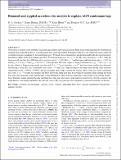Rimmed and rippled accretion disc models to explain AGN continuum lags
Abstract
We propose a solution to the problem of accretion disc sizes in active galactic nuclei being larger when measured by reverberation mapping than predicted by theory. Considering the disc’s exposed-surface thickness profile H(r), our solution invokes a steep rim or rippled structures irradiated by the central lamp-post. We model the continuum lags and the faint and bright disc spectral energy distribution (SED) in the best-studied case NGC 5548 (black hole mass M∙=7×107M⊙, disc inclination i = 45°). With the lamp-post off, the faint-disc SED fixes a low accretion rate M˙≃0.0014 M⊙yr−1 and high prograde black hole spin a• ≃ 0.93, for which rin=2GM∙/c2 and Ldisc=0.25M˙c2. The bright-disc SED then requires a lamp-post luminosity LLP≃5M˙c2/(1−A) for disc albedo A. Reprocessing on the thin disc with T ∝ r−3/4 gives time lags τ ∝ λ4/3 but three times smaller than observed. Introducing a steep H(r) rim, or multiple crests, near r ∼ 5 light days, reprocessing on the steep centre-facing slope increases temperatures from ∼1500 to ∼6000 K, and this increases optical lags to match the lag data. Most of the disc surface maintains the cooler T ∝ r−3/4 profile that matches the SED. The bright lamp-post may be powered by magnetic links tapping the black hole spin. The steep rim occurs near the disc’s dust sublimation radius as in the ‘failed disc wind model for broad-line clouds’. Lens–Thirring torques aligning the disc and black hole spin may also raise a warp and associated waves. In both scenarios, the small density scale height implied by the inferred value of H(r) suggests possible marginal gravitational instability in the disc.
Citation
Starkey , D A , Huang , J , Horne , K & Lin , D N C 2023 , ' Rimmed and rippled accretion disc models to explain AGN continuum lags ' , Monthly Notices of the Royal Astronomical Society , vol. 519 , no. 2 , pp. 2754–2768 . https://doi.org/10.1093/mnras/stac3579
Publication
Monthly Notices of the Royal Astronomical Society
Status
Peer reviewed
ISSN
0035-8711Type
Journal article
Description
Funding: DAS and KH acknowledge support from the UK Science and Technology Facilities Council (STFC) consolidated grant to St.Andrews (ST/M001296/1). DL thanks the Carnegie Foundation for a Centenary Professorship providing support at St Andrews where this investigation was initiated.Collections
Items in the St Andrews Research Repository are protected by copyright, with all rights reserved, unless otherwise indicated.

